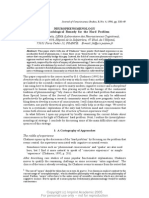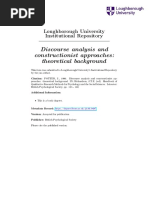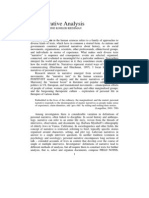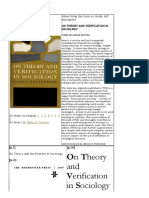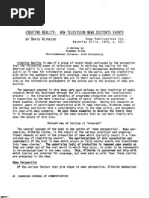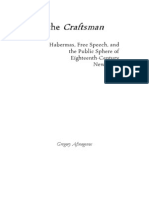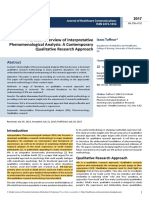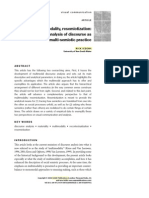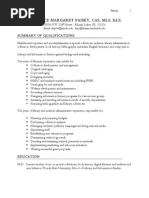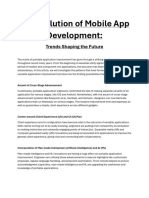Social Construction of Technology
Social Construction of Technology
Uploaded by
Florence Margaret PaiseyCopyright:
Available Formats
Social Construction of Technology
Social Construction of Technology
Uploaded by
Florence Margaret PaiseyCopyright
Available Formats
Share this document
Did you find this document useful?
Is this content inappropriate?
Copyright:
Available Formats
Social Construction of Technology
Social Construction of Technology
Uploaded by
Florence Margaret PaiseyCopyright:
Available Formats
The Social Construction of Technology: Its Conceptual Core Seminar in Theory: LIS 6278 Dr.
Michelle Kazmer
Florence Paisey: Paper Three fmp04@fsu.edu June 2011
Florence Paisey Last week The Wall Street Journal among other organizations, including the Society of American Archivists, reported the British Librarys settlement to collaborate with Google in digitizing 250,000 out-of-copyright books from the Librarys collections (WSJ, 2011). Although the essential technological know-how for accomplishing this
goal has existed for many years, the impetus and resolve to carry out this formidable task has only now come to pass. What is the impetus driving the British Librarys decision? The Library purports that scholars will now have access to facsimiles of rare historical materials. Does the Library know that scholars will embrace these digitized versions? What was the drive underneath a similar settlement between Oxford and Michigan Universities as well as others? What, indeed, was the interest in Oxford Universitys community digitization project? Each of these projects broke with convention, forming new ground in conceptualizing or extending each librarys mission, digitization techniques, project scale, workflow, digital preservation standards, levels of metadata, access points, and issues pertaining to copyright conditions. What controversies and negotiations occurred (and may continue to occur) in implementing these projects? Who were the stakeholders and what conditions did they stipulate? What innovative technologies were applied and what technologies were innovated in bringing the projects to fruition? How have these innovative enterprises influenced social relations, society, cultural institutions, and culture at large? The answers to these questions form the tide behind the impetus, process, and product or potential product of these technological ventures as well as other technological innovations and collaborations. The digitization projects named above (and other technological innovations) are the result of elaborate social, scientific, and technological negotiations. The fabric of these negotiations involves interweaving sociological, scientific, and technical contingencies that shape technologies and, conversely, the technological contingencies that shape the behaviors, culture, and society, giving rise to the technologies. This sociotechnical interlinking engages numerous stakeholders who interpret the meaning of the technology and, ultimately, affect the outcome. The general notion or proposition that technologies are socially constructed may be viewed through a conceptual core where descriptive concepts are defined; facts stated and interrelated logically; generalizations or organizing
Florence Paisey
principles formed, and a lens for analysis of the issues result. This theoretical lens offers a context for gathering and analyzing data, formulating an empirical explanation, and describing the way innovative technologies come about and become integral features of an established, yet interactive and ever-shifting social fabric. One of the seminal papers that describes and sets forth principles aimed at explaining the dynamics of sociotechnical innovation is Pinch & Bijkers The Social Construction of Facts and Artefacts or How the Sociology of Science and the Sociology of Technology Might Benefit Each Other (1984). They state, science and technology are both socially constructed cultures and bring to bear whatever cultural resources are appropriate for the purposes at hand (p. 404). They emphasize that elaborate social, scientific, and technological shaping occurs owing to discourse and negotiations within social and technical environments. The organizing principles inhered in this discourse open the black box of technological development by identifying the actors and agents involved in technological innovation, its perceived applications, utilization, advancement, and integral social enthusiasm. Pinch & Bijker refer to this unit of organizing principles, framework, or theory as the Social Construction of Technology (SCOT). I will argue that SCOT does, indeed, offer a logical set of propositions that, when applied as a unit, will offer an empirical means of understanding how technologies are parleyed, applied, and directed as part of a cohesive, yet fluid, social fabric and construction. However, first let us reflect on the advantages of such a framework or theory. Pettigrew & McKechnie (2001) note the usefulness and pragmatic value of theory. They state, [theory] helps to organize and communicate unwieldy data and simplify the terrible complexities of the social world (p. 62). What is more, theory provides disciplinary boundaries theoretical parameters and a central body of disciplinary knowledge. We associate physics with laws of motion or force through space. We associate biology with the study of organisms and their material structure, differentiation, and genetic composition. We identify psychology with the study of individual behavior. Within psychology, theoretical positions often compete nonetheless, each theoretical perspective aims to understand individual behavior and activity. Moreover, regardless of which behavioral theory one espouses, a scientific or systematic approach to behavior (human or animal) demystifies it and mitigates superstitious attitudes toward behavioral
Florence Paisey diversity. Whether or not one is religious, the effects of religion can be sorted with specific behavioral descriptions. Sociology examines the nature of social behavior social cohesion or assemblages are generally associated with a sense of protection and safety (Merton, 1967). This phenomenon can be observed in both human and animal societies. Theory, then, provides a base for framing research problems, building arguments, and interpreting empirical results (McKechnie & Pettigrew, 1998 p. 125). It enables explanation and some degree of prediction, provides a means of control over as many situations as possible, and establishes a perspective or paradigm to guide research (Glazier & Glover (2002). Theoretical bases in library and information science frame questions and build arguments in bibliometrics, the organization of knowledge, information behavior, information retrieval, or the development and use of communication technologies. Even those who eschew theory understand that defining research problems involves conceptual thinking and developing strategies or procedures
to investigate such problems (Becker, 1998). Theory is an intellectual tool. It is a means of systematically organizing ones questions, observations, and thoughts within conceptual parameters and in an effort to open an unintelligible black box. But, what of theory? Theory is a deductively related set of generalizations or laws (Brodbeck, 1959); a group of logically, interrelated propositions (Merton, 1957); or a generalization that moves from a descriptive level to an explanatory and predictive level in explaining relationships among phenomena (Glazier & Glover, 2002). Sociological theory is concerned with differences and relationships among social phenomena (Gibbs, 1972). Yet, what comprises a theory? Concepts are the building blocks of theory the things being studied, compared, and related to each other (Shoemaker, Tankard, Lasorsa, 2003 p. 15). Sociological theory will compare concepts related to societal assemblages, social behavior, interaction, and inscription or messaging. One can compare or test the reality of concepts when they are not only descriptive, but also variable, relational, and measureable. A descriptive concept of a human being can be compared and measured along a continuum of innumerable characteristics or variables. Variable characteristics include elements like color, size, shape, attitude, or status; these are descriptive, measureable properties variables. When the descriptive property,
Florence Paisey characteristic, or variable of a concept can be related to another variable and examined for its intrinsic verity or truth, the particular concept is a proposition or premise (Brodbeck, 1959). Propositions are significant when one variable changes whenever there is an instance of another particular variable. In other words, when there is a cooccurrence of phenomena with specific, quantifiable variables under specific conditions.
Broderick refers to such significant propositions as generalizations or laws. According to Broderick, a law is simply an empirical or testable assertion that affirms something will happen, under specific conditions or when a specific contingency is present. A logically, interrelated set of propositions or recognized laws is a theory. Glazier and Glover (2002) identify four types of theory substantive theory, middle range theory, formal theory, and grand theory. Pinch & Bijkers theory, the Social Construction of Technology (SCOT), argues that technologies and technological practicesare built in a process of social construction and negotiation, a process often seen as driven by the social interests of the participants (Bijker & Law, 1992 p. 13). The central concepts that arise from this proposition include relevant social groups, interpretive flexibility, the technological frame, inclusion, controversies, stabilization, and closure. Each relevant social group is characterized by particular variables and each group holds a stake in a particular technology or feature of a technology. Each stakeholder or relevant social group characterizes innovations with variant problems and solutions. These stakeholders might be entrepreneurs, economists, politicians, educators, students or any cohesive group with an identity. The interpretive flexibility of the artifact denotes the capacity of the technology to be perceived meaningfully among various stakeholders (relevant social groups). The problems and solutions that these social groups or actors identify trace or map the path of interpretive flexibility its social and technical perception, and the degree to which the artifact can address stakeholders needs, resolve perceived problems with the artifacts, and provide perceived solutions that eventually can result in technological stabilization. SCOT conceptualizes technologies as selected, modified, and shaped during this process of sociotechnical construction and stabilization. The key principles in sociotechnical construction and potential technological success are the interpretive
Florence Paisey
flexibility, the amount of inclusion or perceived meaning that a technology offers, and relevant social groups within a technological frame. This social constructivist perspective on technology identifies, conceptualizes, describes, and explains technological progression and the significant factors in play during its social construction. That is to say, SCOT views technological development as a dialectical sociotechnical construction enacted between innovators and stakeholders or relevant social groups. As a theory, SCOT furnishes an explanation for an applied area of inquiry it aims to explain the success [or failure] of an artefact (Pinch & Bijker, 1984 p. 406). The explanation offered by Pinch & Bijker in their theory of technological social construction hinges on an artefacts fundamental interpretive flexibility. This central principle or law requires that a technology have the capacity for more than one interpretation or application. The potential of a technology to survive involves its degree of interpretive flexibilitythe greater the interpretative flexibility or the capacity of a technology to be perceived meaningfully and integrate features desired by various social groups, the greater the chance of a technology to evolve and survive. Without a high degree of interpretive flexibility, the chances of a technologys survival are limited. Bijker & Law (1992) state, If [technologies] evolve or change, it is because they have been pressed into that shape (p. 3). Successful negotiation of interpretive flexibility requires compromise or the openness to integrate features desired by involved social groups. The perceived problem or uses for which the artifact is intended is the core of the matter. This social construction or interpretation of an artefact takes place within the concept of a technological frame. This technological frame organizes and structures the features by which a technology is perceived and, ultimately, recognized as meaningful or useful by relevant social groups. Seven conceptual elements characterize a technological frame. They include a technologys goal, key problems, problem-solving strategies, current theories, tacit knowledge, perceived substitution function, and exemplary artifacts (Bijker, 1997 p. 141). The greater inclusiveness within the technological frame of relevant social groups the more interest sustains the development of an innovation and its potential closure or acceptance and stabilization.
Florence Paisey Various criticisms and limitations of SCOT have been identified in the literature. Pinch & Bijker, themselves, noted that the degree of stabilization of an artefact depends
on more than just the degree of stabilization of that artefact in [a] social group (1984 p. 424). They state that stabilization will also depend on language or specifications about the artefact and context in which a statement about the artefact is mentioned (a research paper, handbook, newspaper, trade magazine, boardroom, university lecture). Bijkers awareness of this limitation resulted in the concept of a technological frame and inclusion. The elements of a technological frame systematically spell out or elucidate the general issues and solutions that an artefact manages. Bijkers concept of inclusion speaks to the context where the artefact may be used the wider the base of inclusion, the wider the audience and potential interest that sustains development and possible stabilization. Klein & Kleinman (2002) criticize SCOTs view of society as composed of groups (p. 30). They state that SCOT implicitly assumes that groups are equal and all relevant social groups are present in the design process (p. 30). Klein & Kleinman discuss various alternative perspectives on groups that include the power asymmetry among groups, the exclusion of groups from the design process, and the possibility that the entity designated as a group is not a group but a collection of subgroups (p. 31). Fundamentally, Klein & Kleinman as well as Williams & Edge (1996) view SCOT as fatally limited by artificial divisions and assumptions that relate to social structures and their incapacity for equal access to information about a technology as well as equal influence during the design process or construction. These limitations and criticisms are, indeed, warranted. Social groups rarely reach consensus on issueseven if a representative spokesperson is recognized, there is often discord among members. It seems a more granular conception of social influence or relevant social groups is necessary. In addition, the concept of inclusion is incomplete. Relevant social groups are often either dismissed or missingKlein & Kleinman suggest that the concept of groups overlooks social structures that might account for such absences (2002 p. 32). The notion that SCOT overlooks social structures or social features is particularly damaging as those assemblages that are often overlooked may
Florence Paisey simply lack recognition or authority, yet have the knowledge base to offer valuable or life-saving information on design. Finally, these criticisms point to the problem that research can be guided by the
concepts and propositions espoused in a theory. In Beckers terms, the empirical world is shaped to fit a theory (1998). Not only would such practice distort ones research, it also ignores the Kuhnian concept of anomaly and paradigmatic shift that occurs with more of a startling leap than a conventional dialectic. A more granular and precise notion of social and technical interaction would lessen this problem, though it would not offer a complete solution. Nonetheless, despite numerous limitations implicit in the theory of the Social Construction of Technology, this framework brings social influence into the design, utilization, and stabilization of technologies. It is a base from which to distil and refine thought on technological development, application, and stabilization. The concept of interpretive flexibility is particularly significant.
Florence Paisey References Becker, H. S. (1998). Tricks of the trade: How to think about your research while youre doing it. University of Chicago Press: Chicago, IL. Bijker, W. E. (1999). Of bicycles, bakelites, and bulbs. Cambridge, MA: MIT Press. Bijker, W. E. & Law, J. (1992). Shaping technology/building society: Studies in sociotechnical change. Cambridge, MA: MIT. Bijker, W. E., Hughes, T. P., & Pinch, T. (1987). The social construction of technological systems. Cambridge, MA: MIT Press. Brodbeck, May. (1959). Chapter 12 (Models, meaning, and theories). In Gross, Llewellyn (Ed.). Symposium on sociological theory. Evanston, IL: Harper & Row, p. 373-403. Gibbs, J. (1972). Sociological theory construction. Hillsdale, IL: The Dryden Press, Inc. Glazier, J. & Grover, R. (2002). A multidisciplinary framework for theory building. Library Trends, 50, 317-329. Grover, R. & Glazier, J. (1986). A conceptual framework for theory building in library and information science. Library and Information Science Research, 8, 227-242. Kendall, N. (2011, June 20). Google to make British Library archive available online. The Wall Street Journal. Klein, H. & Kleinman, D. (2002). The social construction of technology: Structural considerations. Science, Technology, & Human Values, 27, 28-52. Law, J. (2008). On sociology and STS. The sociological review, 56, 623-649. McKechnie, L. & Pettigrew, K. (1996). Surveying the use of theory in library and information science research: A disciplinary perspective. Library Trends, 50, 406417. McKechnie, L., Pettigrew, K. (1998). Theories for the new millennium: The deployment of theory in LIS research. CAIS-ACSI,125-142. McKechnie, L., Bakewood, L., Greenwood, M., & Julien, H. (2002). Research method trends in human information literature. The New Review of Information Behavior Research, 113-125.
Florence Paisey Merton, R. K. (1967). On theoretical sociology: Five essays, old and new. NY: Macmillan. Pinch, T. J. & Bijker, W. E. (1984). The social construction of facts and artefacts: Or
10
how the sociology of science and technology might benefit each other. Social Studies of Science, 14, 399-441. Shoemaker, P., Tankard, J., Lasorsa, D. (2002). How to build social science theories. Thousand Oaks, CA. Williams, R. & Edge, D. (1996). The social shaping of technology. Research Policy, 25, 865-899.
You might also like
- Set Assignment (R094)Document14 pagesSet Assignment (R094)Ramo KhanNo ratings yet
- Qualitative Methodologies in Organization Studies: Edited by Malgorzata Ciesielska Dariusz JemielniakDocument278 pagesQualitative Methodologies in Organization Studies: Edited by Malgorzata Ciesielska Dariusz JemielniakNgô Thanh NhàngNo ratings yet
- Procedures Manual On Utpras Unified TVET Program Registration and Accreditation System Program Registration (Land-Based)Document82 pagesProcedures Manual On Utpras Unified TVET Program Registration and Accreditation System Program Registration (Land-Based)valcyrus100% (3)
- Couldry, Hepp, The Mediated Construction of RealityDocument4 pagesCouldry, Hepp, The Mediated Construction of RealitycecimarandoNo ratings yet
- Personality Across Cultures: A Critical Analysis of Big Five Research and Current DirectionsDocument14 pagesPersonality Across Cultures: A Critical Analysis of Big Five Research and Current Directionsgogicha mariNo ratings yet
- The Psychogenesis of Knowledge and Its Epistemological SignificanceDocument12 pagesThe Psychogenesis of Knowledge and Its Epistemological SignificanceioanxenakisNo ratings yet
- Brier, Soren - Cybersemiotics. Why Information Is Not Enough PDFDocument498 pagesBrier, Soren - Cybersemiotics. Why Information Is Not Enough PDFJuan Sebastian Jimenez Herrera100% (1)
- Elliott Fischer Rennie 1999Document15 pagesElliott Fischer Rennie 1999pranabdahalNo ratings yet
- Neuro PhenomenologyDocument20 pagesNeuro PhenomenologycacoozrNo ratings yet
- OFS1.Introduction and Common OFS Messages-R13Document23 pagesOFS1.Introduction and Common OFS Messages-R13Preethi GopalanNo ratings yet
- Security Mode Reject (Failure in The Radio Interface Procedure) r3-99b55Document8 pagesSecurity Mode Reject (Failure in The Radio Interface Procedure) r3-99b55Bian HardiyantoNo ratings yet
- The Social Construction of The MaterialDocument14 pagesThe Social Construction of The MaterialDuarte Rosa FilhoNo ratings yet
- Wagenaar Philosophical Hermeneutics and Policy AnalysisDocument31 pagesWagenaar Philosophical Hermeneutics and Policy AnalysisNicolas Alfaro Martin100% (1)
- Discourse Analysis and Constructionist Approaches Theoretical BackgroundDocument32 pagesDiscourse Analysis and Constructionist Approaches Theoretical BackgroundSERGIO ALEJANDRO VELASQUEZ SABOGALNo ratings yet
- Methods of Critical Discourse Analysis WODAKDocument10 pagesMethods of Critical Discourse Analysis WODAKSid Le BossNo ratings yet
- Rouvroy Stiegler EngDocument24 pagesRouvroy Stiegler EngPaulaNo ratings yet
- Riesssman Narrative AnalysisDocument8 pagesRiesssman Narrative AnalysispmjcsNo ratings yet
- Final Paper Guidelines CRM 3335 Bdocx 2Document6 pagesFinal Paper Guidelines CRM 3335 Bdocx 2vj9qcgc5gvNo ratings yet
- Table of Contents CRM3335 BDocument1 pageTable of Contents CRM3335 Bvj9qcgc5gvNo ratings yet
- Review Article: Keywords: Epistemology, Historicity, Experimental Systems, Science As PracticeDocument24 pagesReview Article: Keywords: Epistemology, Historicity, Experimental Systems, Science As PracticeKarl AlbaisNo ratings yet
- The Social Construction of TechnologyDocument25 pagesThe Social Construction of TechnologyAlain ZhuNo ratings yet
- John Hassard Eds The Sociology of Time Palgrave Macmillan UK 1990 PDFDocument267 pagesJohn Hassard Eds The Sociology of Time Palgrave Macmillan UK 1990 PDFGabriela Castro AlvesNo ratings yet
- Rhetoric of Science - Wikipedia PDFDocument14 pagesRhetoric of Science - Wikipedia PDFabresesamoNo ratings yet
- Fischer Kowalski 1Document18 pagesFischer Kowalski 1Daniel MartínezNo ratings yet
- Daniel Eggers - The Language of Desire - Expressivism and The Psychology of Moral Judgement-De Gruyter (2021)Document262 pagesDaniel Eggers - The Language of Desire - Expressivism and The Psychology of Moral Judgement-De Gruyter (2021)ignoramus83No ratings yet
- BNIM - Shortest GuideDocument67 pagesBNIM - Shortest GuideGallagher RoisinNo ratings yet
- The Policy Design Primer. Choosing The Right Tools For They JobDocument78 pagesThe Policy Design Primer. Choosing The Right Tools For They JobAndrea Estefanía Ch100% (1)
- The Logical Structure of Linguistic Theory: Language January 2008Document22 pagesThe Logical Structure of Linguistic Theory: Language January 2008Jasmine ParamithaNo ratings yet
- Brinkmann Friesen 2018 Phenomenologyandeducation PDFDocument18 pagesBrinkmann Friesen 2018 Phenomenologyandeducation PDFGay-Yong DunuanNo ratings yet
- An Interview With Susan FiskeDocument4 pagesAn Interview With Susan FiskenirutnaraNo ratings yet
- Rawls-2009-Harold Garfinkel, Ethnomethodology and Workplace StudiesDocument33 pagesRawls-2009-Harold Garfinkel, Ethnomethodology and Workplace StudiesMarius BertolucciNo ratings yet
- Butler Linguistic VulnerabilityDocument12 pagesButler Linguistic VulnerabilityMeni GeorgopoulouNo ratings yet
- Affectivity, Agency and IntersubjectivityDocument25 pagesAffectivity, Agency and IntersubjectivitymutableS100% (1)
- Research Through DESIGN Through Research - Wolfgang JonasDocument8 pagesResearch Through DESIGN Through Research - Wolfgang Jonasis03lcmNo ratings yet
- Communication Theories University of Twente - UTwente - The NetherlandsDocument194 pagesCommunication Theories University of Twente - UTwente - The NetherlandsBeca CapellaNo ratings yet
- Schutz - Concept and Theory Formation in The Social SciencesDocument17 pagesSchutz - Concept and Theory Formation in The Social SciencesmehmetmsahinNo ratings yet
- Cultures and Organizations: Software of The MindDocument14 pagesCultures and Organizations: Software of The MindAyhan NurselNo ratings yet
- The Zone of Proximal Development As An Overarching Concept A Framework For Synthesizing Vygotsky S TheoriesDocument14 pagesThe Zone of Proximal Development As An Overarching Concept A Framework For Synthesizing Vygotsky S Theoriesannaliesehatton3011No ratings yet
- Boje The Storytelling Organization A Study of Story Performance in An Office Supply FirmDocument26 pagesBoje The Storytelling Organization A Study of Story Performance in An Office Supply FirmmdurcetNo ratings yet
- Sousse Medina: Kantaoui Provide All The Sun-And-Sand Bliss, The Medina District in Sousse'sDocument7 pagesSousse Medina: Kantaoui Provide All The Sun-And-Sand Bliss, The Medina District in Sousse'sAnis SassiNo ratings yet
- Zetterberg, On Theory and Verification in SociologyDocument70 pagesZetterberg, On Theory and Verification in SociologyFlávia FrancoNo ratings yet
- Creating A Political Image: Shaping Appearance and Manipulating The VoteDocument2 pagesCreating A Political Image: Shaping Appearance and Manipulating The VoteBianca HerciuNo ratings yet
- Novelty, Information, and SurpriseDocument259 pagesNovelty, Information, and SurpriseAbram DemskiNo ratings yet
- VanDeth2014 Article AConceptualMapOfPoliticalPartiDocument19 pagesVanDeth2014 Article AConceptualMapOfPoliticalPartiVeeNo ratings yet
- Leavitt - Repression of LanguagesDocument14 pagesLeavitt - Repression of Languagescamille100% (1)
- Herder, Folklore, and Modern Humanism: Lael Weissman University PennsylvaniaDocument15 pagesHerder, Folklore, and Modern Humanism: Lael Weissman University PennsylvaniaakunjinNo ratings yet
- Creating Reality - How TV News Distorts EventsDocument4 pagesCreating Reality - How TV News Distorts Eventskiran-z-1972No ratings yet
- Playing The Craftsman: Habermas, Free Speech, and The Public Sphere of Eighteenth-Century New YorkDocument54 pagesPlaying The Craftsman: Habermas, Free Speech, and The Public Sphere of Eighteenth-Century New YorkGreg Afinogenov100% (3)
- BECKER - The Politics of Presentation - Goffman and Total InstitutionsDocument11 pagesBECKER - The Politics of Presentation - Goffman and Total InstitutionsGerardo DamianNo ratings yet
- A Critical Overview of IPADocument5 pagesA Critical Overview of IPAArchana PooniaNo ratings yet
- Rogers - Goffman On PowerDocument9 pagesRogers - Goffman On PowerPete SamprasNo ratings yet
- The Discursive ConstructionDocument19 pagesThe Discursive Constructionjessica ospinaNo ratings yet
- 2024 Routledge International Handbook of Creative Cognition (Linden J. Ball, Frederic Vallee-Tourangeau) (Z-Library)Document835 pages2024 Routledge International Handbook of Creative Cognition (Linden J. Ball, Frederic Vallee-Tourangeau) (Z-Library)adrianaperrellamNo ratings yet
- Narrative As InquiryDocument10 pagesNarrative As InquirybirknerNo ratings yet
- Krippendorff 2004Document16 pagesKrippendorff 2004sunhutNo ratings yet
- Gephart - Qualitative Research and The Academy of Management Journal From The Editors - 2004Document9 pagesGephart - Qualitative Research and The Academy of Management Journal From The Editors - 2004Alessandra Nogueira LimaNo ratings yet
- A.W RawlsDocument23 pagesA.W RawlsAnne ArtaudNo ratings yet
- The Phenomenology of The Social World Reviewed by JohnDocument5 pagesThe Phenomenology of The Social World Reviewed by JohnSalsabila 1801111335No ratings yet
- Gubrium y Holstein - Narrative Practice and The Coherence of Personal StoriesDocument25 pagesGubrium y Holstein - Narrative Practice and The Coherence of Personal StoriesDamian RojasNo ratings yet
- Social Semiotics Iedema 2007Document29 pagesSocial Semiotics Iedema 2007Tanya VdovinaNo ratings yet
- An Introduction To Design-Based ResearchDocument104 pagesAn Introduction To Design-Based ResearchLeidy Cristina CumbalNo ratings yet
- Imaginative Horizons: An Essay in Literary-Philosophical AnthropologyFrom EverandImaginative Horizons: An Essay in Literary-Philosophical AnthropologyRating: 3 out of 5 stars3/5 (3)
- Envisioning Eden: Mobilizing Imaginaries in Tourism and BeyondFrom EverandEnvisioning Eden: Mobilizing Imaginaries in Tourism and BeyondNo ratings yet
- Digital Culture & Society (DCS): Vol. 3, Issue 2/2017 – Mobile Digital PracticesFrom EverandDigital Culture & Society (DCS): Vol. 3, Issue 2/2017 – Mobile Digital PracticesNo ratings yet
- Bennett Study PresentationDocument16 pagesBennett Study PresentationFlorence Margaret PaiseyNo ratings yet
- Natural and Quasi StudiesDocument4 pagesNatural and Quasi StudiesFlorence Margaret PaiseyNo ratings yet
- Research BarriersDocument9 pagesResearch BarriersFlorence Margaret PaiseyNo ratings yet
- Syllabus ENC 1102Document11 pagesSyllabus ENC 1102Florence Margaret PaiseyNo ratings yet
- Florence Margaret PaiseyDocument5 pagesFlorence Margaret PaiseyFlorence Margaret PaiseyNo ratings yet
- Florence Margaret Paisey, M.S., MLS, Ed.S.: Summary of QualificationsDocument5 pagesFlorence Margaret Paisey, M.S., MLS, Ed.S.: Summary of QualificationsFlorence Margaret PaiseyNo ratings yet
- Haraway"s A Cyborg ManifestoDocument15 pagesHaraway"s A Cyborg ManifestoFlorence Margaret Paisey57% (7)
- The Evolution of Mobile App DevelopmentDocument6 pagesThe Evolution of Mobile App DevelopmentnamitasksrivastavaNo ratings yet
- Technology - CA. Vinay NayakDocument7 pagesTechnology - CA. Vinay NayakKavidhai JsNo ratings yet
- Analyzing Downtime Increases Uptime and Production by Optimizing Operation and Prioritizing MaintenanceDocument7 pagesAnalyzing Downtime Increases Uptime and Production by Optimizing Operation and Prioritizing MaintenanceZegera MgendiNo ratings yet
- Analitical ExpositionDocument18 pagesAnalitical Expositiondanykhoirun11No ratings yet
- Barriers To Effective CommunicationDocument5 pagesBarriers To Effective CommunicationSiddhesh ManeNo ratings yet
- Lecture 4 Notes Social CognitionDocument6 pagesLecture 4 Notes Social CognitionCeline Singh100% (1)
- Atif Javed Student Id No: 317-3004 Subject: Assignment Title & Number: SUBMITTED TO: Ms. Shaheen SultanaDocument71 pagesAtif Javed Student Id No: 317-3004 Subject: Assignment Title & Number: SUBMITTED TO: Ms. Shaheen SultanaSyed Imam BakharNo ratings yet
- Business PlanDocument17 pagesBusiness PlanBandita S NikamNo ratings yet
- Mark Angelo Miranda - STS - Final ExaminationDocument2 pagesMark Angelo Miranda - STS - Final ExaminationMark Angelo MirandaNo ratings yet
- Detailed Proposal BS Cooperative Management Submitted Feb 8 2021Document11 pagesDetailed Proposal BS Cooperative Management Submitted Feb 8 2021Hi Alkaid MagdadaroNo ratings yet
- Executive Summary Thesis SampleDocument6 pagesExecutive Summary Thesis Samplewbeqtpmef100% (2)
- ISA RP60.3 Human Engineering For Control CentersDocument22 pagesISA RP60.3 Human Engineering For Control CentersDaniel Arrieta Darrás100% (1)
- The Role of New Media by Olufemi KunleDocument21 pagesThe Role of New Media by Olufemi KunleEric M AndesNo ratings yet
- Communication ProcessDocument2 pagesCommunication ProcessIndrachapa RanasingheNo ratings yet
- (Paper) - But How Donald Tell Us HowDocument7 pages(Paper) - But How Donald Tell Us HowMécia SáNo ratings yet
- Language Forms and Functions - Ebook Chapter 1Document49 pagesLanguage Forms and Functions - Ebook Chapter 1Harry ChicaNo ratings yet
- Technical Report Writing-ME-303: Arshad MehmoodDocument81 pagesTechnical Report Writing-ME-303: Arshad MehmoodMuhammad AfzalNo ratings yet
- Gold Pre-First - WordlistDocument64 pagesGold Pre-First - Wordlisttomascandioti2008No ratings yet
- Chapter 6 Writing The ReportDocument28 pagesChapter 6 Writing The ReportTibebu SeworeNo ratings yet
- Example Essays-Nursing StudentsDocument20 pagesExample Essays-Nursing StudentsFArah DiAnaNo ratings yet
- FABM1 Module 1Document18 pagesFABM1 Module 1reenana.0813No ratings yet
- Lesson Plan For ObservationDocument5 pagesLesson Plan For ObservationJoyie A Press ToNo ratings yet
- This Study Resource Was: Management Information System MCQDocument9 pagesThis Study Resource Was: Management Information System MCQPrakash prajapati0% (1)
- 03 Nursing Informatics in The Health Care ProfessionsDocument24 pages03 Nursing Informatics in The Health Care ProfessionsByox OhleeNo ratings yet
- Grade 9 - Introduction To IT - ITeS Industries (CH 1)Document13 pagesGrade 9 - Introduction To IT - ITeS Industries (CH 1)Rajesh RanjanNo ratings yet








